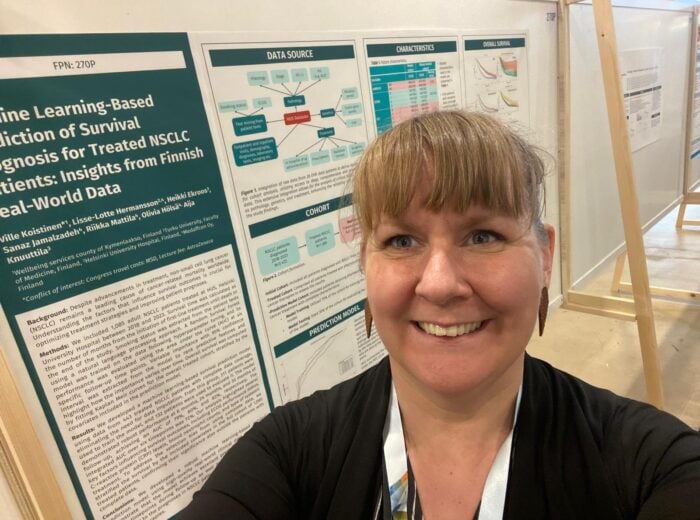Medaffcon Presented Insights from Finnish Real-World Data at European Lung Cancer Congress
Medaffcon's European Lung Cancer Congress (ELCC) poster showcased key findings from a recent study on non-small cell lung cancer (NSCLC).
Health Data Site by Medaffcon
This article was originally published as part of the “Health from Data” blog, which has since been retired. Find all Health from Data blogs here.
My list of publications includes over 20 peer-reviewed scientific articles. One of them is a special one because the Finnish Current Care Guidelines mention it for heart failure. This blog discusses the impact of research by Medaffcon on treatment practices.
Research on real-world data (RWD) begins with certain research questions. The incidence of disease, treatments given to patients, prognosis of a disease, patients’ healthcare resource use (HCRU) and productivity loss are revealed through real-world data. Real-world data also allows for examining patients’ treatment lines.
“Real-world evidence (RWE) can facilitate the access of medicines to patients or improve diagnostics.”
The primary purpose of real-world evidence (RWE) research is to improve patient care, meaning the evidence obtained is intended to be applied to patient treatment. Clinical and animal studies continue to be an important part of drug development, but the value of real-world evidence is constantly increasing. Real-world evidence research reveals the situation of a patient group in real-life. Patients are not selected for the study; instead, real-world data reflects the everyday practices at the units treating patients.
Sometimes, a single RWE study can improve patient care in many ways. The best part is that real-world evidence research may influence treatment practices or recommendations.
A group of experts compiles guidelines for treating a certain patient population based on research evidence. Thus, the guidelines depend on the research world. Treatment guidelines are the basis of every treatment decision. However, guidelines do not bind healthcare professionals or patients to act in a specific way but guide them.
Various countries have their own treatment guidelines. There are also regional guidelines. In Finland, the Current Care Guidelines (Käypä hoito -suositukset) is used; in Sweden, the national care program (nationellt vårdprogram); and in England and Wales, the NICE guidance. The World Health Organization (WHO) creates international treatment recommendations for certain diseases. When the information in a recommendation is considered outdated, the group of experts makes an update. This may be the case when there has been a change in patient care or the presented figures are several years old.
For example, the Finnish Current Care Guideline for heart failure was updated at the end of 2023. In this context, the incidence figures from a study published in the Duodecim Journal by Medaffcon, Bayer, and the cardiologists were included in the Current Care Guidelines.
“Our study indicates that the number of patients suffering from heart failure will increase in the future, which is an important message for the professionals treating these patients.”
The Duodecim Health Library contains not only Current Care Guidelines but other material to support the clinical decision making. The Health Library has over 10,000 articles written by experts; Medaffcon authored several.
A study by Medaffcon, Takeda, and the cardiologists of the Helsinki University Hospital (HUS) is a crucial source in the Health Library’s Medical Book section related to myeloma. The study reports on the characteristics, treatment, and lifespan of Finnish myeloma patients.
“Our finding that the development of treatments has significantly improved the prognosis of myeloma patients has been highlighted as a key part of the medical book’s myeloma text.”
In addition to national recommendations, scientific material, the availability of medicines, and articles published in the international scientific journals influence the treatment practices. Medaffcon has published over 40 peer-reviewed articles across therapeutic areas.
Further, media visibility may help to translate the evidence into treatment practices. As an example, the study of recurrent cardiovascular events of the heart or the brain – conducted by Medaffcon, Amgen, and cardiologists – received widespread media coverage in Finland.
“Our study highlighted the follow-up care of the patients who have suffered the first heart or brain infarction needs to be improved because the risk of death is high if an attack recurs.”
In addition to publicly available material, Medaffcon’s studies and reports have influenced the access to medicines for patients. As an example, the real-world evidence has aided on receiving reimbursability status of a medicine.
In Finnish Media (These are in Finnish):
Tutkimus: Sydän- ja aivoinfarktin uusiutuessa yli 60 % kuolee siihen – potilaiden jatkohoitoa parannettava (amgen.fi)
Tutkimus: sydän- ja aivoinfarktin uusiutuessa yli 60 prosenttia kuolee (iltalehti.fi)
Tutkimus: Yli 60 prosenttia kuolee uusiutuviin sydän- ja aivoinfarkteihin – MTVuutiset.fi
Healthcare professionals always make treatment decisions in the best interest of the patient within the limits of the healthcare service system. Treatment guidelines and other materials support treatment decisions. Treatment guidelines depend on the researchers creating the scientific evidence. Doctors follow the literature in their field and develop the treatment practices accordingly. Bringing new research findings to light is vital to influence the patient care. Sometimes, translating research evidence to treatment practices can take years. Regularly updating the guidelines are essential to quickly support clinical work with new research findings.

Medaffcon's European Lung Cancer Congress (ELCC) poster showcased key findings from a recent study on non-small cell lung cancer (NSCLC).

Johan Rehnberg started working as a Scientific Advisor at Medaffcon’s Swedish office in August 2024. He is a dynamic researcher who values opportunities to learn new things and develop his skills – opportunities that Medaffcon provides.

The algorithm was originally developed to extract smoking status from patient texts with purpose to analyze the effects of smoking on postoperative complications. Today, it is also being utilized in lung cancer research.

Sr. Scientific Advisor
PhD
liisa.ukkola-vuoti@medaffcon.com
Liisa joined Medaffcon in January 2020. She has over ten years of experience of working as a scientific advisor and research scientist for private and public sector organizations. Liisa holds a PhD in medical genetics, and she mentions that especially the therapeutic areas related neurology and psychiatry appeal to her.
Liisa’s strengths include strong expertise on medical sciences and research, as well as on creating evidence-based content, because she also has experience of being a science book author. Establishing cross-scientific collaboration, scientific exchange, and creating networks are one of her key work philosophies.
One of her main professional interests is the secondary use of health-related data to create real-world-evidence in order to improve and develop treatment practices. ”Due to the unique registries and data lakes available in Finland, in principle all the required data is already available or accumulating all the time, which makes it important to utilize this real-world-data to improve patient care and general well-being.”